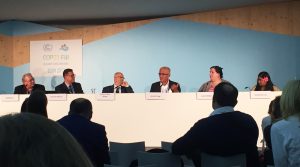I was very intrigued heading into COP23 to see how the issue of climate change-induced displacement would be treated. Since the issue had been given very little attention in most past COPs, I wasn’t expecting a whole lot, perhaps one or two side events. But there were some aspects to this COP that made it a little more likely that climate change-induced displacement would be a big topic.
Number one was the Fijian Presidency. Labeled as the ‘Pacific COP,’ there would probably never be a better chance to raise the issue at a COP. The Pacific islands were most immediately threatened by sea level rise, with some countries like Kiribati buying land in other countries to prepare for what some consider an inevitable need to relocate their population. Others, including Fiji, had already been forced to relocate some villages to higher land. The second reason was the impact that natural disasters had had on a number of countries around the world in the past year. Hurricanes had ravaged the Caribbean, forcing a number of people to move. For example, the entire population of the island of Barbuda had been forced to temporarily relocate to its sister island of Antigua after the hurricane season destroyed everything on the island. On the other hand, widespread flooding had forced thousands to migrate in South Asia, particularly in India and Bangladesh. Surely, there would have to be some discussion on the issue. And there definitely was, at least among the side events.

Former President of Kiribati, Anote Tong, speaking on a panel about climate change-induced displacement. Tong came up with the concept of “migration with dignity” in the context of climate change-induced displacement to put forward a more proactive measure to deal with the issue.
I alone attended nine side events during the week that focused on climate change-induced displacement. I had been told that there were seventeen scheduled during the entire COP, an unprecedented number in many ways. And this was just the number of events focusing explicitly on displacement. There were a number of other events on loss and damage (L&D) more broadly, and issue that included displacement. So I have no doubt in saying that it must have come up in multiple other forums. Having been unable to attend the actual negotiations themselves, I cannot say how much state interest there was on the issue. But it was clear to me that civil society most definitely recognized the urgency and need to talk about big questions and challenges – displacement will only increase as sea levels continue rising and natural disasters become more intense and frequent with continued climate change.
I had a few key takeaways on the issue based on the events I attended. The first one was about the placing of displacement under the UNFCCC architecture. Human mobility had been first mentioned in an official document in the Cancun Adaptation Framework. Since then, displacement had found a home under the issue of L&D after the Paris COP; the Paris decision asked for the establishment of a Task Force on Displacement under the Warsaw International Mechanism on Loss and Damage, the official body under the UNFCCC framework working on L&D.
The second major takeaway was regarding one major debate around the issue – the terminology to be used to characterize those who had been forced to move due to climate change. Many in mass media refer to such an individuals as “climate refugees.” However, a number of different actors disagree with this terminology for a variety of reasons. Institutional actors such as the UN High Commissioner for Refugees (UNHCR) and the Platform on Disaster Displacement (PDD) do not agree with this terminology, as the phrase “climate refugee” has no standing in international law. While a refugee is entitled to specific protections under the 1951 Refugee Convention, these do not apply to someone who has been displaced because of climate change. Unlike certain actors who are calling for an expansion of the refugee definition to include these people, UNHCR and PDD argue that there is no political will to reopen the 1951 Convention, meaning that efforts on those ends will only be a waste of time. Instead, there are ongoing discussions as to what other general principles can be agreed for the international protection of such individuals.
Others disagreeing with the use of the “climate refugee” term are people from the Pacific Islands. As the former President of Kiribati, Anote Tong, mentioned in multiple events I attended, they do no want to be called refugees because they do not want to be seen as victims. Instead, he proposes the idea of “migration with dignity,” a proactive measure to relocate where people prepare for the move much in advance instead of a reactive move so that people who are forced to migrate do not lost their dignity. And yet there are others I spoke to who disagree with this approach, saying that if you romanticize the notion of migration, it might have adverse impacts on mitigation efforts. No longer will states feel the urgency and need to undertake more ambitious mitigation efforts to prevent temperatures from rising further.
Many of the debates are still at a nascent stage as the issue is only starting to get prominence at the COPs. But it is inevitable for the issue to become more and more salient every successive year – and it will be interesting to see how the COP approaches things in the years to come.

